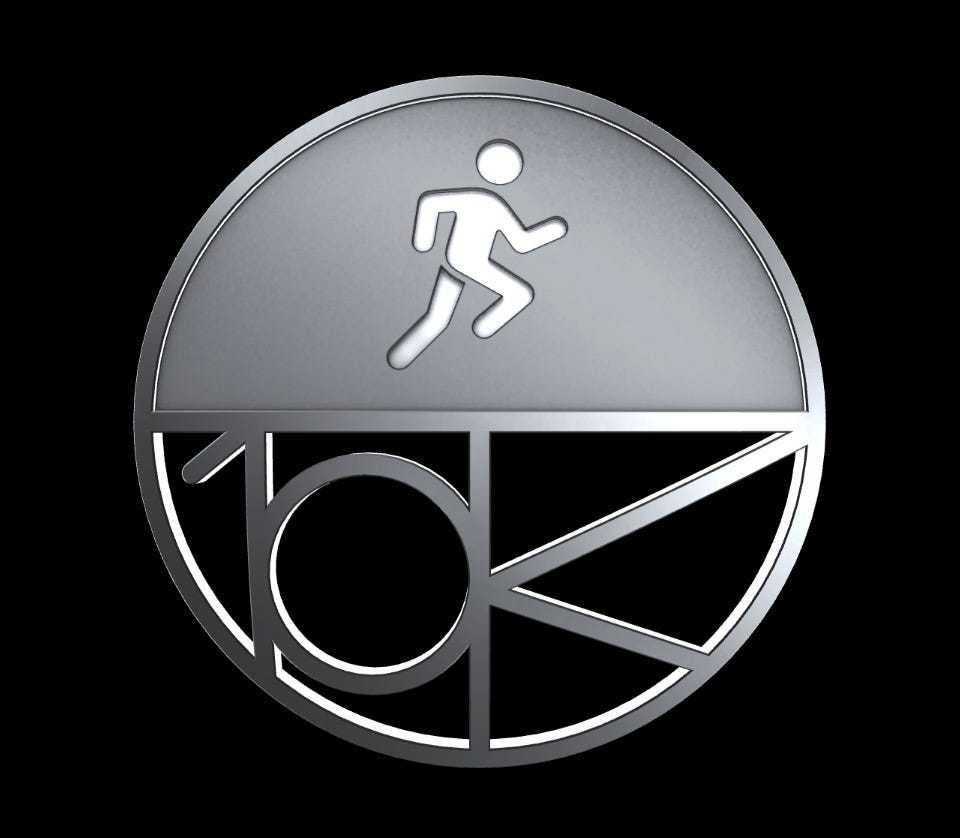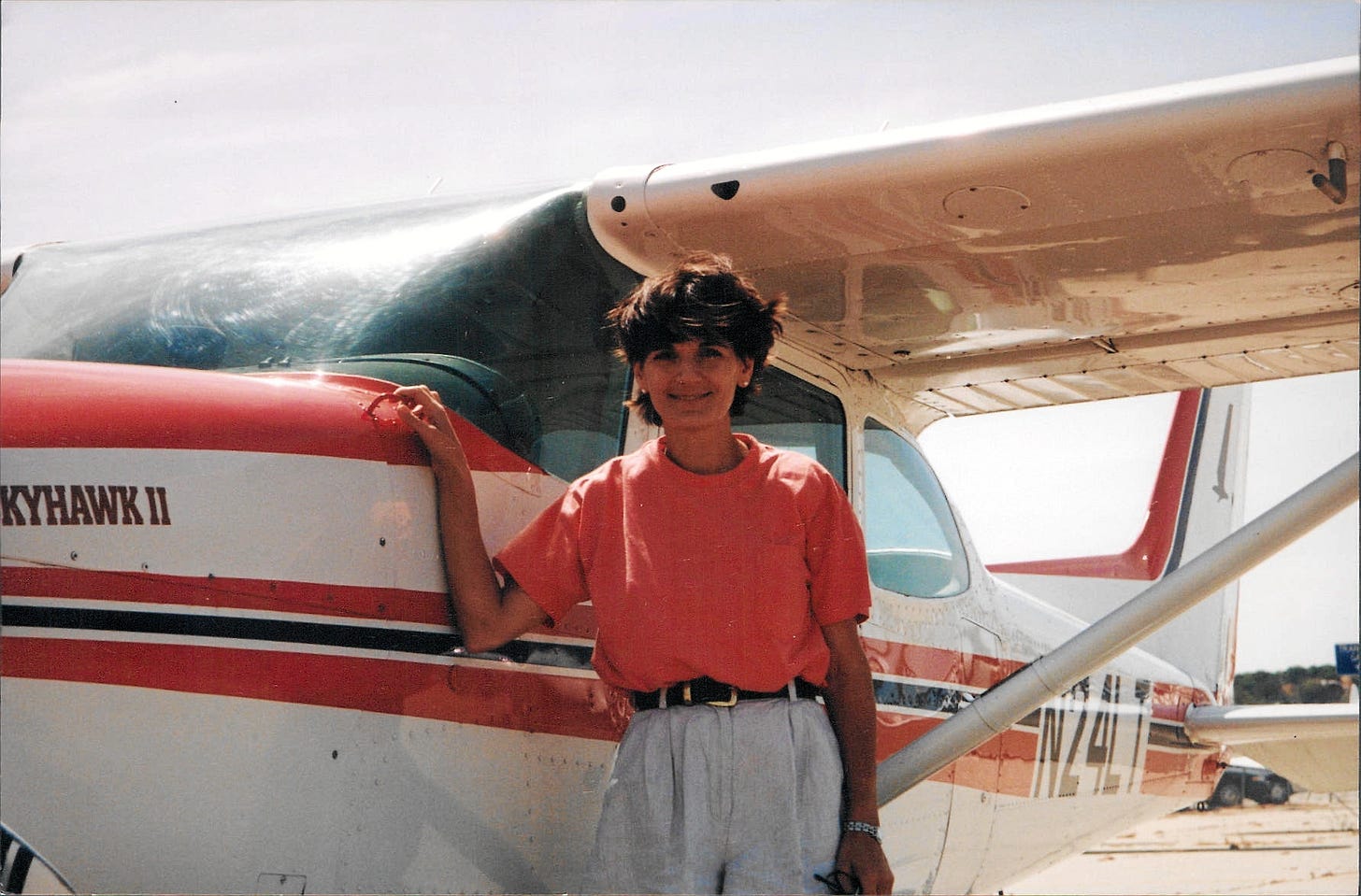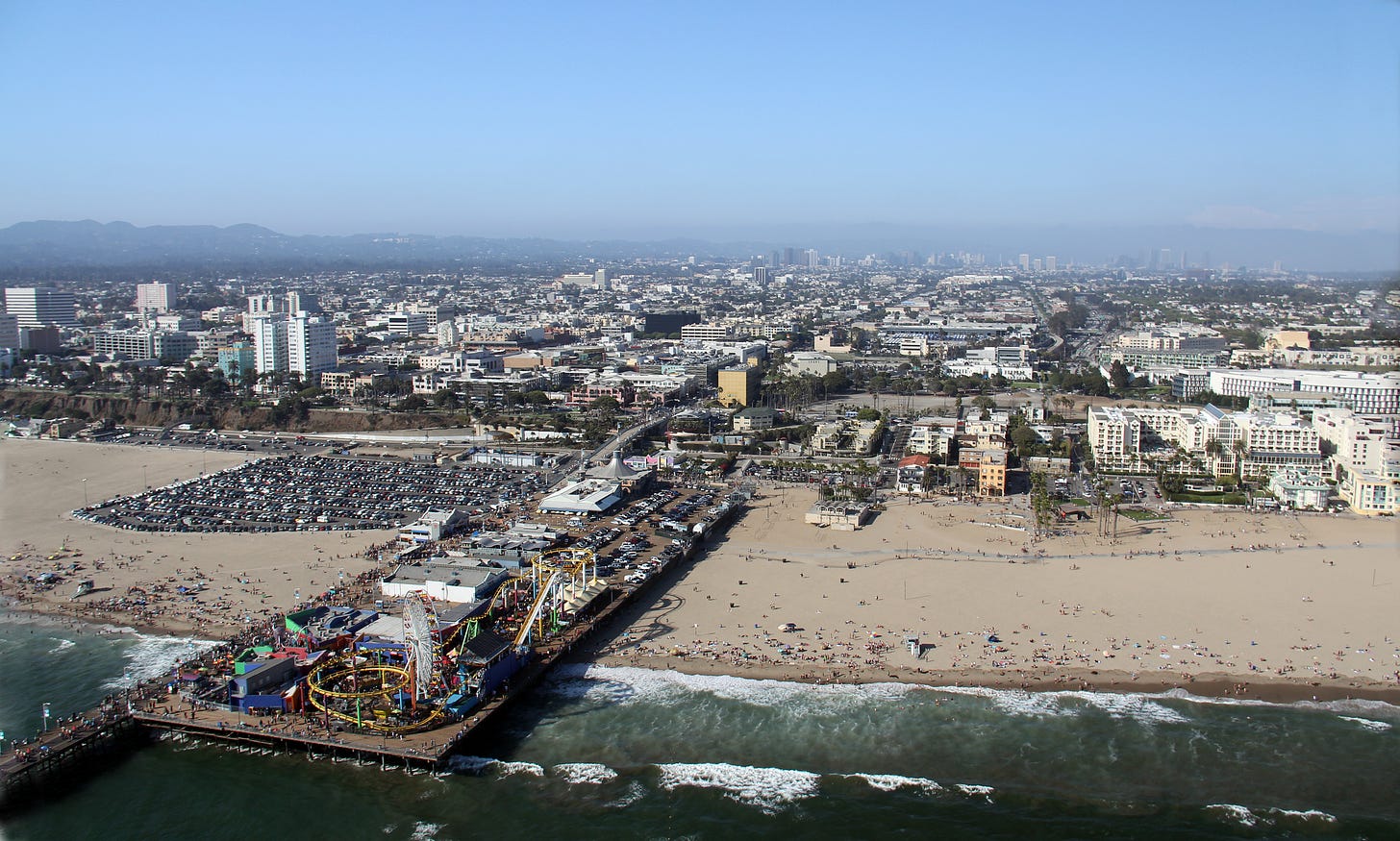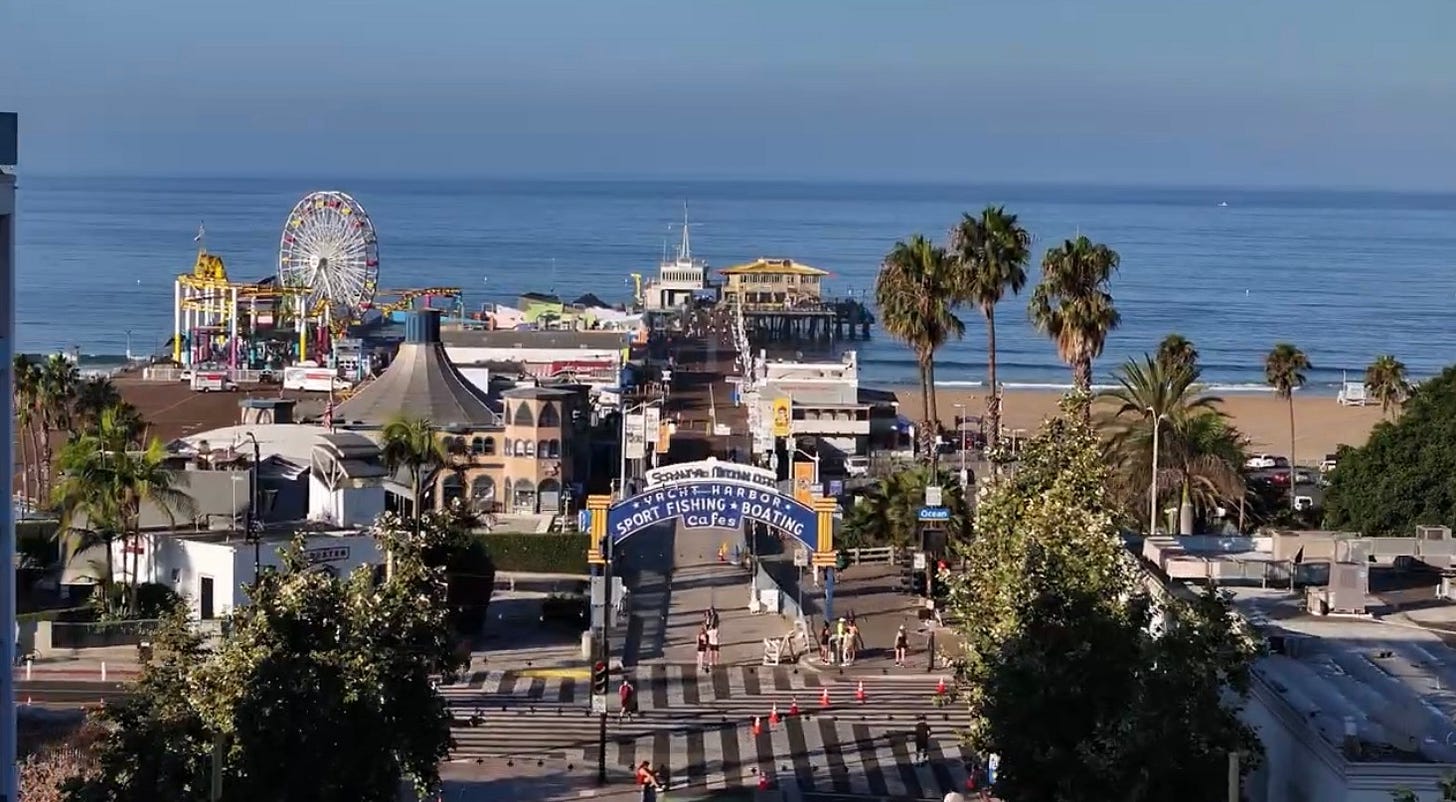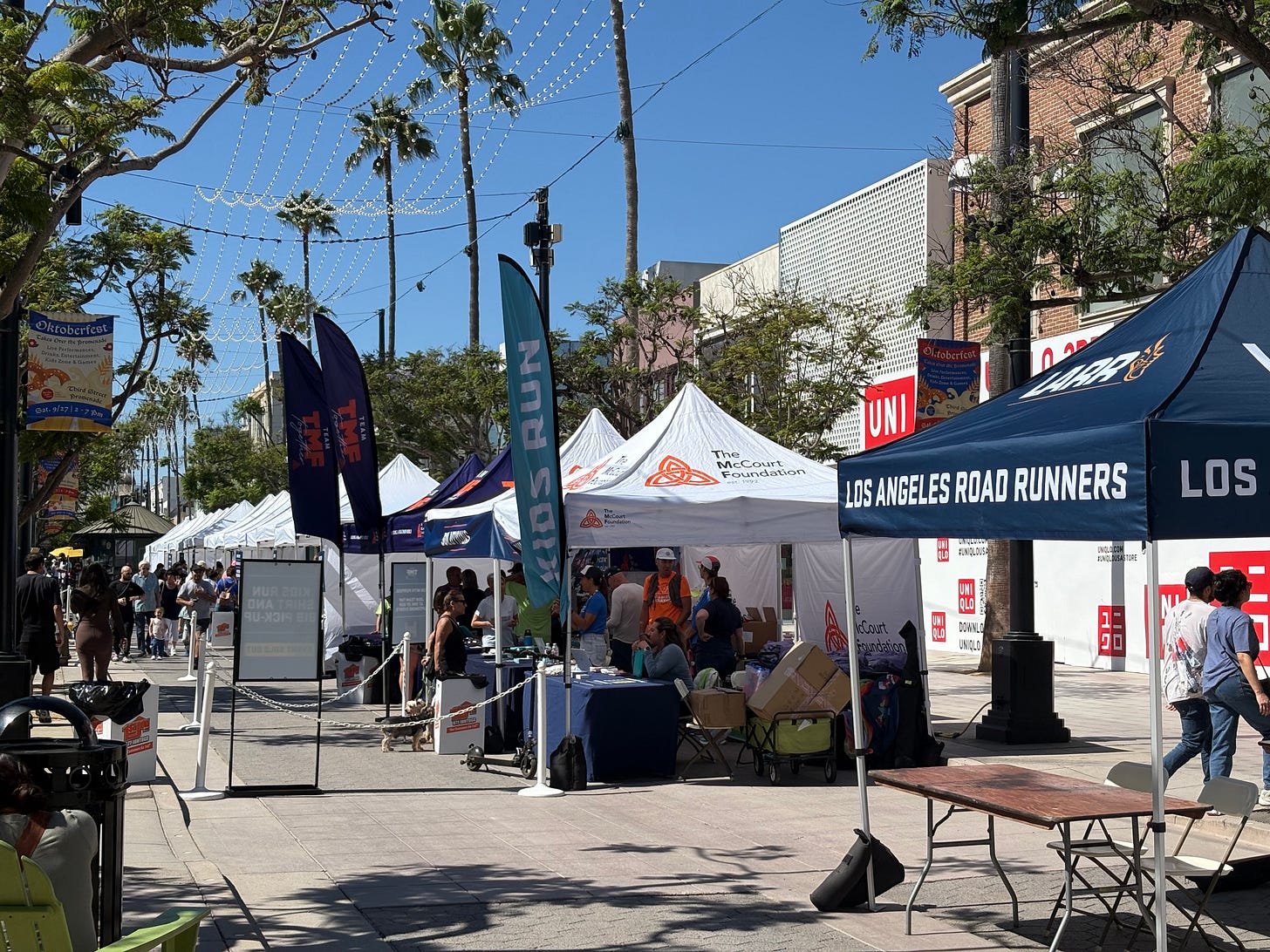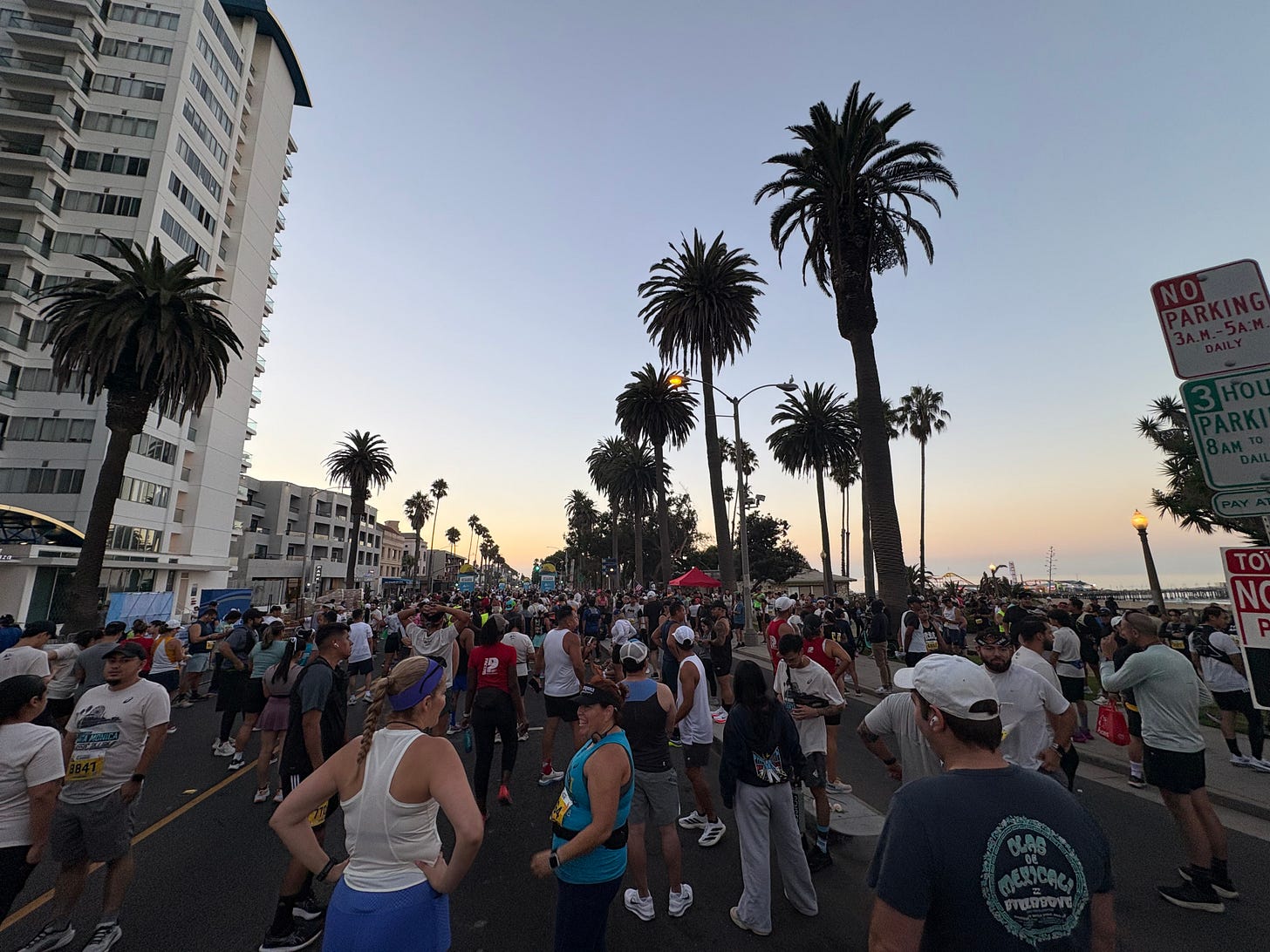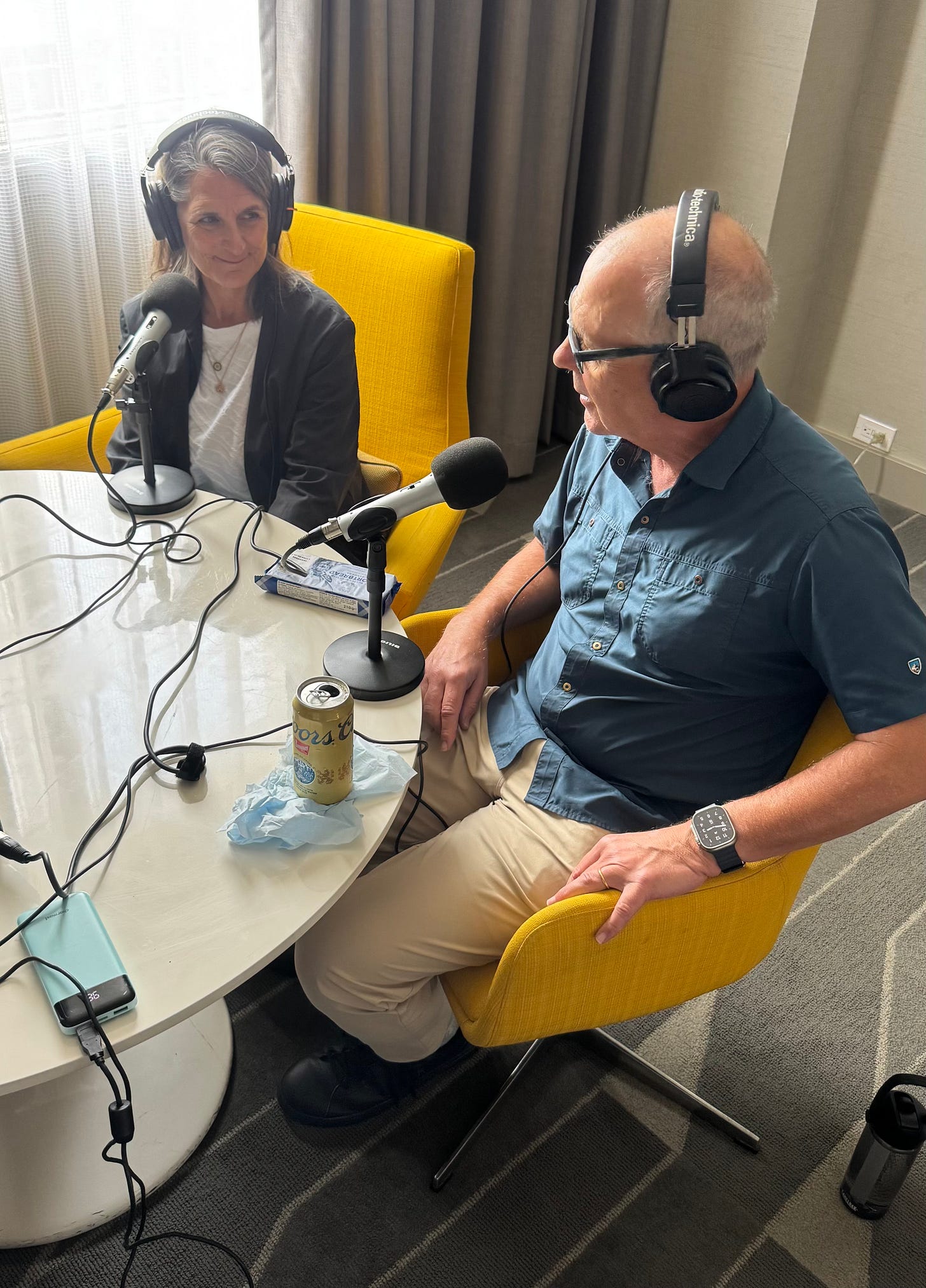Santa Monica Classic: The case for 10K
Why 6.2 miles is a great distance. Plus: Los Angeles’ underwhelming race calendar and improving public transport system. Avgeekery. And my wife and I are guests on a non-rev podcast at Dorkfest.
Here’s a post arising from a couple of back-to-back trips to Los Angeles recently. As usual, it’s a mix of running, aviation, and travel. Most of my running posts are about half marathons, but this one starts with a discussion of the 10K distance.
In praise of 6.2 miles (a.k.a. 10K)
The North American running world is selective with its embrace of the metric system. You’ll never see a half marathon in the U.S. refer to itself as a 21.1-kilometer event. It’s always 13.1 miles. Same with 26.2 for the full. But, for some reason, U.S. runners do join with others worldwide in referring to “5K” and “10K” distances — the “K” short for thousand meters or kilometers.
A 10K course is 6.214 miles. So a bit under half of a half marathon (which is 6.55 miles). It’s a great distance. It’s long enough to be something of an endurance run, but also very manageable. I aspire to do a 6-mile run — roughly a 10K — every week, unless travel, weather, injury, or other things get in the way. That means I can do a 10K race with no special training, unless I’m out to prove something with my speed (which I’m usually not).
Although a 10K is almost half of a half marathon, I would say it requires less than half the effort in terms of gearing up and doing it on the day. Does that make it a bit less satisfying? Yes, probably (at least, if you are used to running 13.1 miles). But it is still a great workout, and one that involves less risk of injury.
In fact, if I had to settle on just a single distance for all my runs — recreational ones on my own as well as races — it would undoubtedly be the 10K. It’s a versatile, one-length-fits-all type of distance. If I get to the point of retiring from half marathons (and I am already past my peak, such as it was), I can see myself making the 10K my “thing.”
Serious runners — as opposed to recreational types like me — probably take the view that if you’re running a 10K, you should aim for a faster pace than with a half marathon. There’s some logic there. Personally, though, I tend to cruise at roughly the same sort of pace. However, there’s less chance with a 10K of a slowdown in the second half (something I try to avoid, whatever the distance, in my quest for even splits). So my average pace may end up a bit faster.
Some large marathons and half marathons have 10K events as add-ons. These can be good choices if you want to partake in the big event without running the big race. But there can be a slight “B-team” vibe to a 10K run alongside something with “marathon” in the name. So perhaps the best type of 10K is the standalone variety in which that is the distance (or, at least, the longest distance). There are relatively few major standalone 10K races, as opposed to small local events. I’ve reviewed a couple in this blog — the Adidas Paris 10K and the Great Ethiopian Run in Addis Ababa (both of which I highly recommend). Recently, I ran another, the Santa Monica Classic.
The underwhelming Los Angeles race calendar
Santa Monica is part of Los Angeles. It’s a tony area on the ocean about nine miles north of the Los Angeles International Airport. It actually has its own small airport, used only by private aircraft. When my wife and I owned our Cessna 172, we occasionally flew in there from our home base in Santa Barbara some 90 miles away.
With its long beachside bike path stretching to Venice Beach and beyond, Santa Monica is a great place to go running on your own if you’re visiting LA. But LA overall is surprisingly under-served when it comes to races. Oddly, there is no such thing as “the Los Angeles Half Marathon,” either in name or spirit. Yes, there are half marathons that take place within Los Angeles County (although not that many). But none that really aspire to be a flagship running event.
Recent LA race history is strewn with memories of half marathons that didn’t quite make the cut and didn’t endure. One example is the Hollywood Half, my first-ever half marathon back in 2012. Others include the Los Angeles Rock-n-Roll, the LA Run to Remember, and the LA Allstate 13.1. None even aspired to be events on a par with, say, the New York Half Marathon or even the San Francisco one.
Los Angeles does have a large full marathon, but that tends to punch below its weight on the global running stage. It’s not the sort of race where there’s any difficulty securing a place. It’s no London or Tokyo.
I’m not sure why LA hasn’t been able to host world-class races. It may, in part, be to do with the sheer number of separate cities that make up Los Angeles County. Visitors often don’t realize that places like Santa Monica, Beverly Hills, West Hollywood, Culver City, Pasadena, and a bunch of others are not simply neighborhoods, but actual separate cities within LA County alongside LA City itself. There are, in fact, a total of 88 cities within Los Angeles County. And, no doubt, the proliferation of jurisdictions makes permitting and policing all the more complicated and expensive if you want to chart a 13.1-mile course through the metropolis.
That, apparently, was the reason why the full Los Angeles Marathon ended up scaling back from the iconic route it used to follow all the way from the Rose Bowl Stadium to the Santa Monica Pier. The LA Marathon — back in the days when that was the route — was the one-and-only full I ever did. Today, that race no longer reaches the coast.
There is, however, one large race that takes place wholly within Santa Monica. And that is the aforementioned Santa Monica Classic, which is put on by the same race organization — the McCourt Foundation — that produces the full marathon (as well as a half in Pasadena).
Santa Monica Classic overview
The Santa Monica Classic consists of a 10K and a 5K. It begins and ends close to the Santa Monica pier. It takes place each year early in September. I’ve been meaning to run it for a while, and finally got around to it this year.
Santa Monica isn’t a parking paradise, but most people arrive by car. As discussed later, it is actually quite well connected to the rest of Los Angeles by public transport, but it might be challenging to take advantage of that in time for the 7 AM race start.
If, like me, you are visiting LA, there are hotels within walking distance of the race, but they are expensive. I stayed in a Hampton Inn less than a 15-minute walk away, which had an urban vibe not typical of that chain. The words “Hampton Inn” typically conjure up visions of sub-$200, but I paid $300 even after applying some Hilton points to bring the price down from something closer to $400.
This race sells out, usually several weeks ahead of the event. I paid $105 about a month before when it was close to selling out, but you can do better price-wise if you commit further in advance.
Packet pickup the day before the race is outdoors on the Third Street Promenade, a pedestrianized street at the heart of Santa Monica’s shopping area. It was quick and efficient. You can also pick up your packet early on race morning, but be prepared for lines. I walked past them on my way to the start line and was glad I already had my bib.
The main race sponsor is ASICS, the Japanese running company. A sponsor like that raises hope of decent shirts. Sadly, that was not the case here. The race entry did include a shirt, and it was ASICS-branded, but it was barely worth picking up. It was a cotton shirt. No one should run in cotton shirts, let alone in a climate like California’s. The only running shirts worth having are made of a tech material of some sort. I’m totally fine with races not bundling a shirt into the price. That’s pretty common in other countries. But if you are going to offer a race shirt, make it one that runners might actually want to run in. I’m surprised that ASICS wanted to lend its name to a shirt like that.
There is no race-day gear storage. I wouldn’t really expect it with a 10K. But it’s a factor to keep in mind if you do want to pick up your bib on race morning and do want to keep the low-grade shirt.
The race day experience
I did my full day-before-the-race thing in terms of stuffing myself with bagels and eating a pasta dinner. It was probably overkill for a 10K. The extra carbs I took in the day before were more than those I burned off during the race. But that’s just part of my race ritual. It helped create the mindset.
Runners started to gather on race morning as the sun was coming up. It was perfect running weather given the time of year when it can be hot. The previous year, they cancelled the 10K because of the heat.
The overall race start atmosphere was somewhat muted. I get it that loudspeaker announcements and music can be jarring. But they do help build up some electricity in the half hour or so before a race begins. Here, there was literally no race morning vibe other than what the runners themselves brought to the event. Not a single announcement before the start. No music. No national anthem. Nothing.
But the race did begin more or less on time. The start was confusing, however. About a minute after passing through the start arch with the timing mats, runners had to go through a second, narrower arch where there were more mats of some sort. This caused the runners to have to slow down to a walking pace as they were funneled through — and at one point, they came to a complete halt.
Why this second arch? Maybe it was for the start of the 5K, which went out later. But it made no sense. It was also confusing. I’d started my watch as I passed through the first arch, but I then wondered whether the second one was actually the start. However, I think the first was the real start, as the finish time on my watch at the end of the race correlated exactly with the official chip time. But the slow start cost me around 45 seconds on my first split.
Even after I got through the second arch, it was slightly slow going at first, with an unusually large number of walkers in the first quarter mile. The race organizers don’t even try to corral runners at the start according to anticipated pace.
The course — apparently a bit tweaked from previous years — was pretty flat, but with a bit of an incline in the second half. It was a decent course that made you feel you were in Santa Monica well enough. But if you are expecting to be running in close proximity to the ocean for the six and a bit miles, think again. For most of the first half, you are not in sight of the ocean as the course wends its way a bit inland. It then loops back and takes you past the start line headed northbound. You have better views in the second half. But you’re still quite far set back from the ocean. I have much better views on my regular home-town runs in Santa Barbara. I’m a bit spoiled in that regard.
If running in sight of the Pacific isn’t something you do all the time, you’ll like this course. For me, it was fine — but nothing special. Given that this is too large a race to be on the bike track, a bit closer to the water, I’m not sure the organizers could have come up with a much better course than they did.
Overall, I enjoyed the Santa Monica Classic 10K. I’d recommend it. But I think the organizers could have done a better job with a few things — the third-rate shirt, the muted start, and the confusing and annoying second arch. It’s a fine event if you look at it as a local/regional race. But it lacks a certain something. Compared with, say, the Paris Adidas 10K, it really wasn’t in the same league in terms of a big-city event of this distance. And it probably doesn’t aspire to be and, realistically, could never be. When it comes to urban landscape, the Santa Monica Pier just isn’t the Arc de Triomphe or the Eiffel Tower.
Los Angeles public transport
My preferred means of getting to Los Angeles is train or plane. Car comes a distant third. But it’s one thing getting to the city, it’s another moving around within it. Many people don’t even consider public transport, imagining that it is only for those whose economic means leave them no choice. But public transport within Los Angeles is better than people often imagine — and there have been some improvements lately.
One of the main improvements is that LAX is now finally getting connected to the city’s metro system. The new LAX Transit Center opened earlier in 2025 and provides a stop on the subway as well as a bus station. Right now, you still have to take a shuttle bus from the passenger terminals to the Transit Center. Soon, however, there will be a 2.25-mile “elevated guideway train system” that will whisk passengers to and fro as well as taking them to new offsite parking and car rental facilities. Ticketing for both the bus and metro is easy if you add a TAP Card to your phone.
I find taking public transport in cities goes well with non-revving. There’s something asymmetrical about spending much more money on your transportation on the ground within a city than it costs you to get there by air. I also take the bus whenever possible to get to the airport in my home town.
I took the short United flight from Santa Barbara to LAX to get to the race. Not many people do use this for point-to-point travel. Like most routes that are this short, it is priced for revenue passengers to make it attractive only to those who connect onto other flights. After some quality time in the very spacious United Club on arrival — enjoying the terrace with great runway views — I took a bus from the Transit Center to the heart of Santa Monica a block or two from packet pickup. The fare was just $1.25, compared with probably at least $50 if I’d taken an Uber. The bus made a lot of stops, but was fine.

Returning to LAX after the race, I took the metro, with one change along the way. That cost me a little more, $1.75. The Santa Monica metro stop was very close to my hotel. There was a mix of overground and underground along the way. There weren’t many other passengers for most of the way to LAX that Sunday morning. The trains were very clean, as nice as you’ll find in any city.

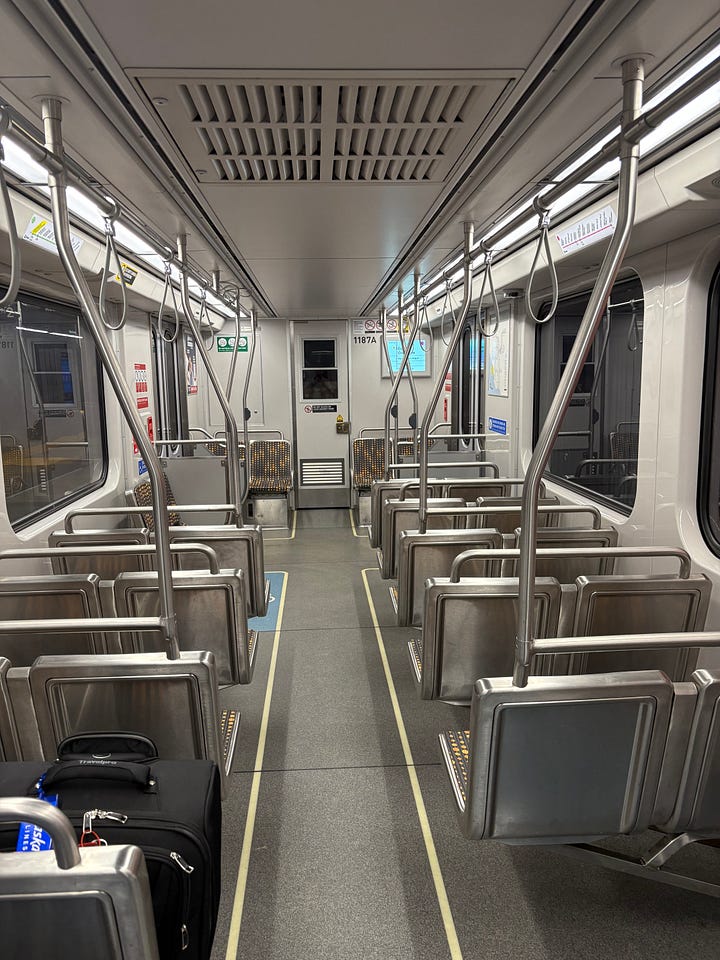
An unspoken — or maybe spoken — reason why a lot of people don’t use public transport in LA is fear of crime. And it obviously only takes one bad incident to change one’s experience. I’m not sure I felt less safe taking it there than in other cities in the U.S.A. But, yes, compared with places like Canada, Europe, Australia, and Japan, public transport in U.S. cities can be a bit edgy. I was on the phone with my wife while at the Transit Center, telling her how nice it was, when some guy who I thought just wanted change tried to scam me out of $20 (which he didn’t get). But he was perfectly polite about it.
So, yes, you need to have your wits about you. But I felt fine venturing out between LAX and Santa Monica and would readily do it — and similar routes — again. But I’m not sure I’d take public transport in LA late at night or in some parts of the city.
Avgeeks, and a podcast appearance back in Los Angeles
I was back in Los Angeles the following week, this time taking Amtrak to Burbank Airport station. I had to go for a work thing (yes, I do have a day job). It took place at the Sheraton Universal, a slightly dated but borderline-iconic LA hotel with some period flavor that allows it (just) to get away with being a bit past its prime. My daughter was attending another part of the same event, coming in from the Bay Area, and so my wife joined us as well, making it a family jaunt.
The morning after, we headed for LAX — but not to get on a plane, at least not that day, but to go to Dorkfest. I’ve posted about Dorkfest before, but — in brief — it’s a gathering of aviation geeks (“avgeeks”) that takes place every September at LAX. My post about it comes up prominently when you search about the event on Google.
My daughter — although a keen traveler — certainly isn’t an avgeek. It’s debatable whether my wife — an airline pilot — is, but I tend not to think of her as one. People who fly professionally can be all into aviation (although some surprisingly are not), but not necessarily from a “geek” perspective. One of the litmus tests of whether an airline professional is an avgeek — and some are — may be what they do with their spare time. I myself — and I’m not an airline professional — am on the avgeek spectrum, though much less than some people.
There are some serious and very knowledgeable avgeeks at Dorkfest. We met one such person who had purchased no less than 12 revenue-passenger, round-trip tickets for himself on Alaska’s new nonstop service from Seattle to Seoul, all to be completed within a matter of months. He didn’t have any particular connection with South Korea, and booked the flights so that he mostly turns around and heads back immediately after getting there. But he got some great deals — as one sometimes can on new routes — so why not?
I probably wouldn’t have gone to Dorkfest this year, but for the fact that my wife and I had been invited to be guests on a podcast, The Non-Rev Lounge, two of whose hosts were attending and recording there. It’s one of my favorite podcasts, and I’d been listening to it — mostly while running — for almost three years. It’s put on by three people — a flight attendant, gate agent, and ramp worker — who work for a major U.S. airline.
To listen to our appearance, look out for episode 238 wherever you get your podcasts. The episode ran for over an hour, and covered a lot of ground — this blog (which my wife describes as “curiously compelling”), how my wife and I met through aviation, how she got into aviation and then returned to the airlines after a 25-year break while we were raising a family, our non-rev travel strategies and experiences, and more.
Quite soon after our episode went live, the podcast announced a hiatus. One of the presenters — Lara, the flight attendant — was retiring. I hope the podcast does return in one form or another, as they had created something that, in the world of non-rev life and avgeekery, seemed to be developing quite a following. ✈️ 🏃
If you’ve stumbled across this post, please consider subscribing to this blog using the button below. It covers the intersection of running, travel, and aviation, and includes race reviews from around the world. Subscribing costs nothing (and never will). You’ll get an email every couple of months or so with new posts. Please also share this post with anyone you think might be interested.

